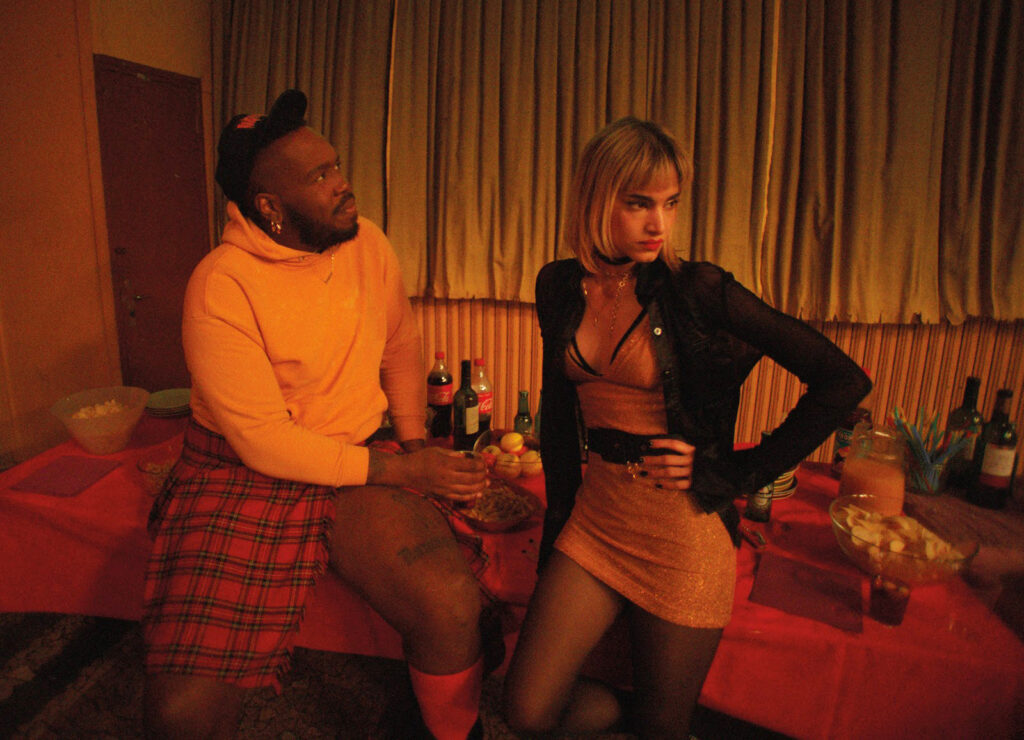In “Climax,” a French dance troupe joyfully celebrate after rehearsal of an ambitious routine in a remote community centre. Their jubilation turns to ash as it eventually it becomes clear that the sangria has been spiked with LSD. What spawns from this is pandemonium as the dancers turn on each other to identify the culprit and their intoxication strips them down from superego to id, leaving only their worst impulses to clash unmitigated. This an unyielding fever dream that stuns and ensnares with its colourful cruelty.
The film opens on a plane of snow as the camera pans down onto a lone bloodied woman, trudging through her way through. She is clearly possessed by pain and desperation, which propel her even as her body gradually succumbs. The camera keeps its distance with an unshifting gaze, merely rotating around the hopeless scene. This serves as the perfect harbinger of the form that “Climax” will take and role that the audience will play as unwilling witnesses. The more discomforting things get, the more weighted the cameras’ movements become until we are fixed to the ground with the characters, stumbling through their personal hell with them. The audience is subjected to a sequence of terrible events; yet the cameras remain transfixing and play with our perspective to build an immersion that makes us feel just as trapped in this experience as these misfortunate characters.
Interestingly, the horror of “Climax” lies in its realism. Director Gaspar Noé refrains from using any special effects to warp the reality of what we see, and the nightmarish quality is achieved through practical components of the film such as the blaring music, bold lights, and disorienting camera.
It cannot be overstated that when these different components come together, the result is a sensory overload. Noé’s use of colour creates a psychedelic storm that projects the fear and nausea filling each of the inebriated dancers. From the scornful reds and bitter blues flooding the many rooms, to the shadowy and vacant corridors that promise a new hell wherever they lead, Noé crafts his own makeshift purgatory out of an otherwise mundane setting.

As the situation escalates, these colours feel harsher and more otherworldly whilst the sound is warped to match this. Bouncy dance tracks in the background shift into sharper and more grating forefront noise, while once joyful laughter becomes a sardonic torment. On top of these practical shifts, the events that transpire here are all tangible terrors. We only see the mania of the characters from the outside and this only makes their mortifying actions all the more distressing to see. The sheer dread that sets in as we realise things will only get worse is overwhelming.
“Climax” also boasts a unique structure with a great payoff for the audience. The first half is unnervingly comforting and steady, knowing that the following series of events will at some point take us to the what we were shown in the opening. The film takes this time to leisurely place all of its dominoes before swiftly toppling them down. We are first introduced to the ensemble of characters in an extended single-take dance scene that showcases not only their skill and passion but also their personalities. We are also shown audition tapes for each of the dancers that act as abridged character bios, surmising their hopes, fears, and motivations. These even serve as foreshadowing, alluding to some of the fates that befall them in the brutal latter half, which is ushered in by a smooth mid-film credits sequence during a second dance scene.
Despite this approach sounding effective and fitting on paper, it is perhaps not as effective as one would hope in terms of rich characterisation. There is little to these characters even before their drug-induced degeneration. Members of the ensemble feel one-dimensional, with flaws or problems that are time-bombs waiting to explode when the film decides it is time to deliver another blow to the audience. If they were easier to invest in, these characters may have felt less like fuel for Noé’s mayhem machine, and these blows may have had more emotional weight rather than yielding only shock value.
Fortunately the nature of “Climax” benefits from the focus on these tragic events as the pulse of the film is the visceral anxiety that joins each one to the next. Moreover, the lack of a script and use of improvised lines may have meant less purposeful dialogue tailored to convey specific information to the audience. As a result, fixed characterisation and writing was sacrificed in favour of naturalism—a trade-off the film benefits from tonally as both the character interactions and stakes feel believable. This consideration for authenticity extends even down the casting as the film primarily uses actual dancers with no acting experience.
Gaspar Noé takes no prisoners as he torments the audience by compelling them to bear witness to his unbridled chaos. “Climax” is an engrossing and at times even torturous frenzy that will hold you captive. This vibrant experience becomes a stress-inducing watch that will grant you no respite once it gets going. If you think you are prepared, you are gravely mistaken.